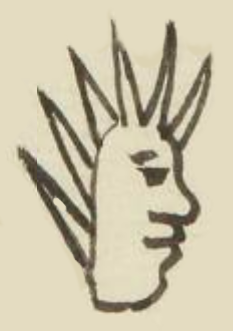Huitznahua (MH908r)
This black-line drawing of the simplex glyph for the personal name Huitznahua is attested here as a man’s name, title, or perhaps occupation (such as mandón or alguacil, in Spanish, as explained in the Codex Mendoza). The glyph shows the head of a man in profile, looking toward the viewer’s right. Six thorns (huitztli) protrude from the outer perimeter from the top and back of the man’s head. He has no hair. It is unclear how the rest of the name might be represented visually, if at all. Perhaps the thorns are considered to be near (-nahuac) the head, which would be a near homophone for the -nahua ending to the name.
Stephanie Wood
The Codex Mendoza tlacuilo’s rendering of Huitznahuatl (Mdz66r), two decades earlier, uses a phonetic speech scroll for the -nahuatl ending to the person’s name or title. ohn Bierhorst (A Nahuatl-English Dictionary and Concordance to the Cantares Mexicanos, 1985, 143) says that Huitznahuatl was a "name or epithet of a god to whom slaves were sacrificed in Mexico." Other sources report that one of the ethnic groups that migrated from the Seven Caves came from a place called Huitznahuac, and there was a temple with this association in Mexico Tenochtitlan. Finally, Huitznahuatl was a high title, and it had an association with the South. The name was not inaccessible for tribute-paying men of humble means, such as found in the census of modern-day Morelos and in the Matrícula de Huexotzinco (modern-day Puebla). See the Online Nahuatl Dictionary for more information about Huitznahuac and Huitznahuatl, and see some examples of other glyphs, below, for making comparisons.
Stephanie Wood
matheo huitznava
Mateo Huitznahua
Stephanie Wood
1560
Jeff Haskett-Wood
espinas, títulos, oficios, nombres de hombres

Huitznahuatl, a lordly title, perhaps an occupation, and the name of a ruler, https://nahuatl.wired-humanities.org/content/huitznahuatl
Huitznahuac, a place, a calpolli from Chicomoztoc, an ethnicity, warrior-dancers, https://nahuatl.wired-humanities.org/content/huitznahuac
-catl, affiliation suffix, https://nahuatl.wired-humanities.org/content/catl
huitz(tli), a thorn or spine, https://nahuatl.wired-humanities.org/content/huitztli
-nahuac, next to, https://nahuatl.wired-humanities.org/content/nahuac
nahua(tl), language, https://nahuatl.wired-humanities.org/content/nahuatl
(un título, o un oficio)
Stephanie Wood
Matrícula de Huexotzinco, folio 908r, World Digital Library, https://www.loc.gov/resource/gdcwdl.wdl_15282/?sp=886&st=image
This manuscript is hosted by the Library of Congress and the World Digital Library; used here with the Creative Commons, “Attribution-NonCommercial-ShareAlike 3.0 License” (CC-BY-NC-SAq 3.0).




